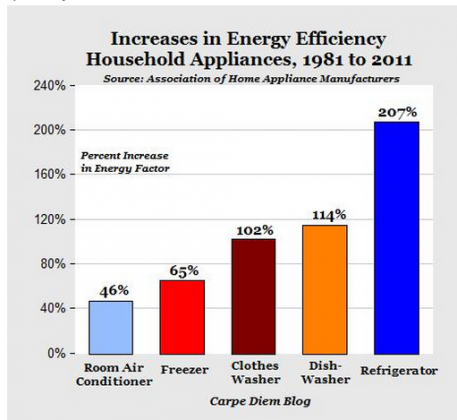“Davidson” Submits:
Last week I indicated that inflation measures showed relatively low inflation of 1.7% and that this appeared to be headed lower. I had a few responses that this could not be correct as food and energy were higher. The issue I think is that we are most sensitive to those items we see every day, but less sensitive to the many other items we buy infrequently. Mark Perry wrote about the dramatic efficiencies which have occurred in everyday appliances the past 30yrs. I have extracted excerpts from Perry’s recent blog below which is well worth reading. Link
The US is a society in which ” faster, better, cheaper” products and services are constantly replacing earlier the more expensive, less useful and problem prone. We make choices each day along these lines. This is quite easy to see in the once ubiquitous vinyl record which was replaced by discs and then by digital files. Today we routinely carry the music, books on tape and even movies with us for consumption on demand in handheld devices. The ability to do this was something only imagined on Startrek of the 1960s. Although food and energy do cost more in nominal terms, the prices of almost everything else are falling in real terms as technology advances and we produce ever “faster, better, cheaper”
The inflation indices attempt to capture this and over all they appear to do a good job of it. The people who construct this indices do not have a bias but to do provide the best representation of the information as best as they can. Net/net they are not politicos favoring one party vs. another. They are dedicated data wonks keen at constructing the best index of whatever they are trying to measure as expertly as they can.
The reason for constructing an inflation index is precisely because most do not see the net effect of price changes and tend to overestimate inflation’s effect. The best index in my opinion is the 12mo Trimmed Mean PCE which shows inflation at 1.7% today and suggests that it may fall over the next 12mos. Julian Simon discussed human ingenuity in the process of achieving continuous efficiency improvement in all aspects of human endeavor. The Ultimate Resource 2 by Julian Lincoln Simon (Jul 1, 1998)
I have argued and continue to argue that deflation is the natural human condition. The only reason we have inflation is excess government printing of currency which I have argued should be reduced to be more equal to human productivity.
What is occurring with inflation is more than food and energy.
Excerpts:
December 1, 2012
The “good old days” are now: today’s home appliances are cheaper, better, and more energy efficient than ever before
Mark J. Perry | December 1, 2012, 12:19 pm
Thanks to ongoing advances in energy-saving technologies, the chart above shows the significant increases in the energy efficiency of five common home appliances based on historical data that were just released by the Association of Home Appliance Manufacturers (AHAM) for the years 1981 to 2011. Those improvements in energy efficiency translate into significant energy cost savings for American households. According to a press release from the AHAM, U.S. consumers could save $90 per year on average if they replaced their 10-year old refrigerator, clothes washer and dishwasher with today’s energy efficient models. The savings from lower operating costs would be even greater when comparing today’s modern models to the appliances of 20 or 30 years ago.
Bottom Line: Today’s modern household appliances are not only cheaper than ever before, they are the most energy-efficient appliances in history, resulting in additional savings for consumers through lower operating costs. The average dishwasher today is not only more than twice as energy-efficient as a comparable 1981 model, but its cost today is only about 1/3 the price of the 1981 dishwasher, measured in what is ultimately most important: our time. Put those two factors together, and the average American’s dishwasher today is about six times better than the dishwasher of thirty years ago.
Stated differently, if dishwashers hadn’t fallen in price by a factor of three since 1981, and if they hadn’t improved in energy efficiency by a factor of more than two, Americans today might be paying more than $1,000 for a basic dishwasher instead of $300, and it would take more than twice as much energy to operate. Likewise, we would expect comparable large decreases in the amount of work time required to buy the other four appliances, along with significant reductions in operating costs due to their increased energy efficiency.
